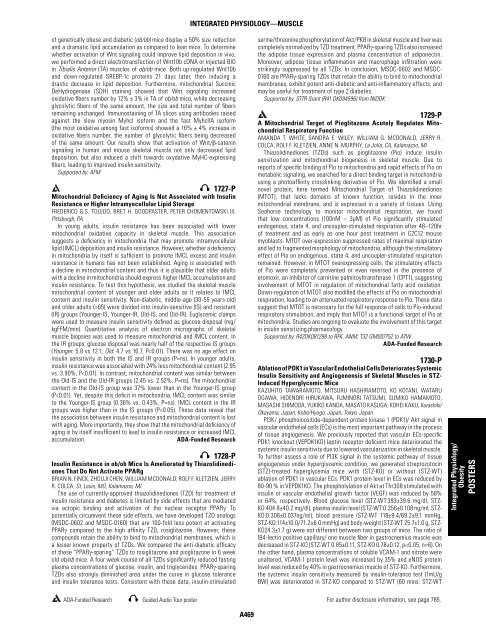2011 ADA Posters 1261-2041.indd - Diabetes
2011 ADA Posters 1261-2041.indd - Diabetes
2011 ADA Posters 1261-2041.indd - Diabetes
Create successful ePaper yourself
Turn your PDF publications into a flip-book with our unique Google optimized e-Paper software.
of genetically obese and diabetic (ob/ob) mice display a 50% size reduction<br />
and a dramatic lipid accumulation as compared to lean mice. To determine<br />
whether activation of Wnt signaling could improve lipid deposition in vivo,<br />
we performed a direct electrotransfection of Wnt10b cDNA or injected BIO<br />
in Tibialis Anterior (TA) muscles of ob/ob mice. Both up-regulated Wnt10b<br />
and down-regulated SREBP-1c proteins 21 days later, then inducing a<br />
drastic decrease in lipid deposition. Furthermore, mitochondrial Succinic<br />
DeHydrogenase (SDH) staining showed that Wnt signaling increased<br />
oxidative fi bers number by 12% ± 3% in TA of ob/ob mice, while decreasing<br />
glycolytic fi bers of the same amount, the size and total number of fi bers<br />
remaining unchanged. Immunostaining of TA slices using antibodies raised<br />
against the slow myosin MyhcI isoform and the fast MyhcIIA isoform<br />
(the most oxidative among fast isoforms) showed a 16% ± 4% increase in<br />
oxidative fi bers number, the number of glycolytic fi bers being decreased<br />
of the same amount. Our results show that activation of Wnt/β-catenin<br />
signaling in human and mouse skeletal muscle not only decreased lipid<br />
deposition, but also induced a shift towards oxydative MyHC-expressing<br />
fi bers, leading to improved insulin sensitivity.<br />
Supported by: AFM<br />
& 1727-P<br />
Mitochondrial Defi ciency of Aging Is Not Associated with Insulin<br />
Resistance or Higher Intramyocellular Lipid Storage<br />
FREDERICO G.S. TOLEDO, BRET H. GOODPASTER, PETER CHOMENTOWSKI III,<br />
Pittsburgh, PA<br />
In young adults, insulin resistance has been associated with lower<br />
mitochondrial oxidative capacity in skeletal muscle. This association<br />
suggests a defi ciency in mitochondria that may promote intramyocellular<br />
lipid (IMCL) deposition and insulin resistance. However, whether a defi ciency<br />
in mitochondria by itself is suffi cient to promote IMCL excess and insulin<br />
resistance in humans has not been established. Aging is associated with<br />
a decline in mitochondrial content and thus it is plausible that older adults<br />
with a decline in mitochondria should express higher IMCL accumulation and<br />
insulin resistance. To test this hypothesis, we studied the skeletal muscle<br />
mitochondrial content of younger and older adults as it relates to IMCL<br />
content and insulin sensitivity. Non-diabetic, middle-age (30-55 years-old)<br />
and older adults (>65) were divided into insulin-sensitive (IS) and resistant<br />
(IR) groups (Younger-IS, Younger-IR, Old-IS, and Old-IR). Euglycemic clamps<br />
were used to measure insulin sensitivity defi ned as glucose disposal (mg/<br />
kgFFM/min). Quantitative analysis of electron micrographs of skeletal<br />
muscle biopsies was used to measure mitochondrial and IMCL content. In<br />
the IR groups, glucose disposal was nearly half of the respective IS groups<br />
(Younger: 5.8 vs 12.1; Old: 4.7 vs 10.7, P
















